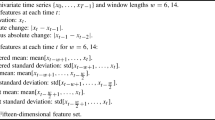Abstract
This is the first of two articles which apply certain principles of inference to a practical, financial question. The present article argues and cites arguments which contend that decision making should be Bayesian, that classical (R. A. Fisher, Neyman-Pearson) inference can be highly misleading for Bayesians as can the use of diffuse priors, and that Bayesian statisticians should show remote clients with a variety of priors how a sample implies shifts in their beliefs. We also consider practical implications of the fact that human decision makers and their statisticians cannot fully emulate Savage's rational decision maker.
Similar content being viewed by others
References
Berger, James. (1985).Statistical Decision Theory and Bayesian Analysis, 2nd ed., New York: Springer-Verlag.
Berger, James, and Thomas, Sellke. (1987). “Testing a Point Null Hypothesis: The Irreconcilability of P Values and Evidence,”Journal of the American Statistical Association 82, 112–139.
Birnbaum, Allan. (1962). “On the Foundations of Statistical Inference,”Journal of the American Statistical Association 57, 269–326.
Birnbaum, Allan. (1968). “Likelihood,”International Encyclopedia of the Social Sciences, 299–301.
Birnbaum, Allan. (1969). “Concepts of Statistical Evidence.” InEssays in Honor of Ernest Nagel: Philosophy, Science and Method. New York: St. Martin's Press, pp. 112–143.
Black, Fischer, and Myron Scholes. (1973). “The Pricing of Options and Corporate Liabilities,”Journal of Political Economy (May/June), 637–654.
Blattberg, Robert, and NicholasGonedes. (1974). “A Comparison of the Stable and Student Distributions as Statistical Models for Stock Prices,”Journal of Business 47, 244–280.
Bollerslev, Tim, RayChou, and KennethKroner. (1992). “ARCH Modeling in Finance: A Review of the Theory and Empirical Evidence,”Journal of Econometrics 52, 5–59.
Box, George. (1980). “Sampling and Bayes' Inference in Scientific Modeling and Robustness,” (with discussion),Journal of the Royal Statistical Society 143, Part 4, 383–430.
Buehler, Robert. (1959). “Some Validity Criteria for Statistical Inferences,”Annals of Mathematical Statistics 30, 845–863.
Chamberlain, Gary. (1983). “A Characterization of the Distributions that Imply Mean-Variance Utility Functions,”Journal of Economic Theory 29, 185–201.
deFinnetti, Bruno. (1937). “La Prevision: Ses Lois Logiques, Ses Sources Subjectives,”Annals de l'Institute Henri Poincaré 7. English translation in H. E.KyburgJr. and H. G.Smokler (eds.),Studies in Subjective Probability. New York: John Wiley & Sons. (1964).
DeGroot, Morris. (1970).Optimal Statistical Decisions. New York: McGraw-Hill.
Dexter, Albert, J.Yu, and WilliamZiemba. (1980). “Portfolio Selection in a Lognormal Market When the Investor Has a Power Utility Function: Computational Results.” In M. A. H.Dempster (ed.),Stochastic Programming. New York: Academic Press, pp. 507–523.
Edwards, Ward, HaroldLindman, and LeonardSavage. (1963). “Bayesian Statistical Inference for Psychological Research,”Psychological Review 70, 193–242.
Fama, Eugene. (1963). “Mandelbrot and the Stable Paretian Hypothesis,”Journal of Business 36, 420–429.
Fishburn, Peter. (1981). “Subjective Expected Utility: A Review of Normative Theories,”Theory and Decision 13, 139–199.
Good, I. J. (1956). “The Surprise Index for the Multivariate Normal Distribution,”The Annals of Mathematical Statistics 27, 1130–1135; 28 (1957), 1055.
Hildreth, Clifford. (1963). “Bayesian Statisticians and Remote Clients,”Econometrica 31, 422–438.
Hlawitschka, Walter. (1994). “The Empirical Nature of Taylor-Series Approximations to Expected Utility,”American Economic Review 84, 713–719.
Jeffreys, H. (1939).Theory of Probability. Oxford University Press; (1948), 2nd ed.
Kroll, Yoram, HaimLevy, and HarryMarkowitz. (1984). “Mean Variance versus Direct Utility Maximization,”Journal of Finance 39, 47–61.
Levy, Haim, and HarryMarkowitz. (1979). “Approximating Expected Utility by a Function of Mean and Variance,”American Economic Review 69, 308–317.
Lindley, D. V. (1957). “A Statistical Paradox,”Biometrika 44, 187–192.
Lindley, D. V. (1972).Bayesian Statistics, A Review. Philadelphia: Society for Industrial and Applied Mathematics.
Machina, Mark. (1984). “Temporal Risk and the Nature of Induced Preferences,”Journal of Economic Theory 33, 199–231.
Machina, Mark, and David, Schmeidler. (1992). “A More Robust Definition of Subjective Probability,”Econometrica 60, 745–780.
Mandelbrot, Benoit. (1963). “The Variation of Certain Speculative Prices,”Journal of Business 36, 394–419.
Markowitz, Harry. (1959).Portfolio Selection: Efficient Diversification of Investments. New York: John Wiley & Sons; (1991), 2nd. ed, Basil Blackwell Cambridge, MA.
Markowitz, Harry, DonaldReid, and BernardTew. (1994). “The Value of a Blank Check,”Journal of Portfolio Management 20, 82–91.
Markowitz, Harry, and NiluferUsmen. (1996). “The Likelihood of Various Stock Market Return Distributions, Part 2: Empirical Results,”Journal of Risk and Uncertainty 13, 221–247.
Pulley, Lawrence. (1981). “A General Mean-Variance Approximation to Expected Utility for Short Holding Periods,”Journal of Financial and Quantitative Analysis 16, 361–373.
Pulley, Lawrence. (1983). “Mean-Variance Approximations to Expected Logarithmic Utility,”Operations Research 31, 685–696.
Ramsey, Frank. (1931). “Truth and Probability” (1926); “Further Considerations” (1928). InThe Foundations of Mathematics and Other Logical Essays. London: Kegan Paul, and New York: Harcourt, Brace and Co.
Savage, Leonard. (1954).The Foundations of Statistics. New York: John Wiley Sons; (1972), 2nd ed., Dover. Securities Training Corporation. (1995).National Commodities Futures, Series 3.
Shafer, Glenn. (1982). “Lindley's Paradox,”Journal of the American Statistical Association 77, 325–351.
Simaan, Yusif. (1993). “What is the Opportunity Cost of Mean-variance Investment Strategies?”Management Science 39, 578–587.
Young, William, and Robert, Trent. (1969). “Geometric Mean Approximation of Individual Security and Portfolio Performance,”Journal of Financial Quantitative Analysis 4, 179–199.
Zellner, Arnold. (1971).An Introduction to Bayesian Inference in Econometrics. New York: John Wiley & Sons.
Author information
Authors and Affiliations
Additional information
Rutgers University
Rights and permissions
About this article
Cite this article
Markowitz, H.M., Usmen, N. The likelihood of various stock market return distributions, part 1: Principles of inference. J Risk Uncertainty 13, 207–219 (1996). https://doi.org/10.1007/BF00056153
Issue Date:
DOI: https://doi.org/10.1007/BF00056153




